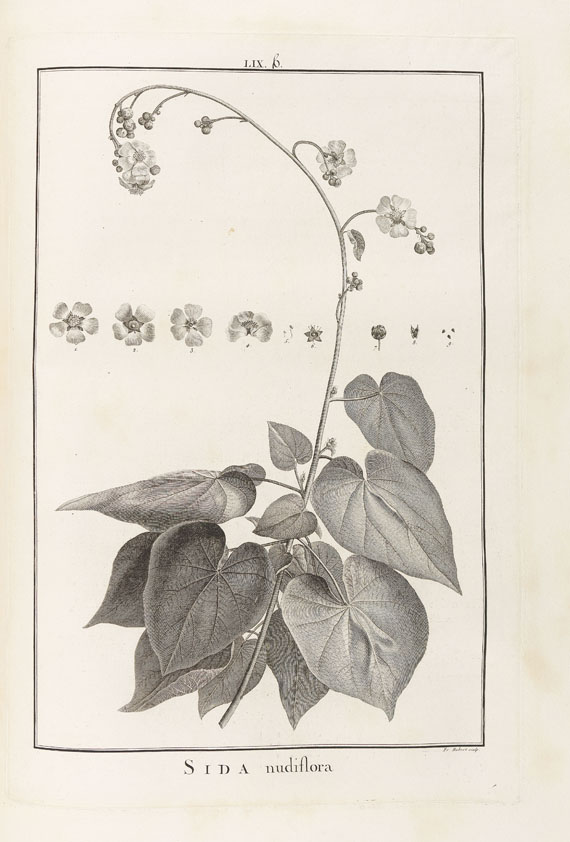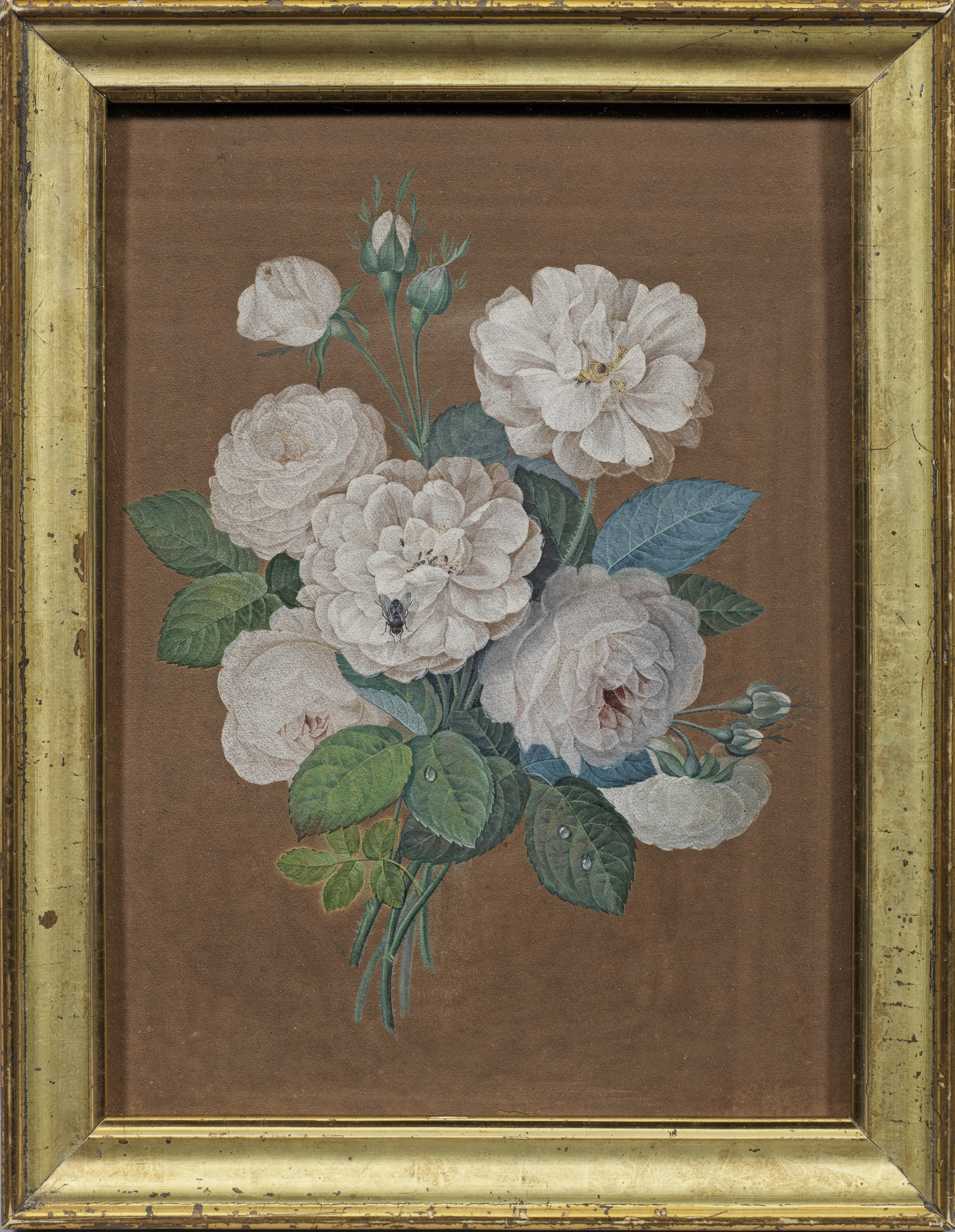Charles-Louis L'Héritier de Brutelle
3 botanical works bound together, comprising:
Geraniologia, seu erodii, pelargonii, geranii, monsoniae et grieli historia iconibus illustrata. Paris: Pierre-François Didot 1787-1788. 44 plain engraved plates (33 after Redouté, 6 after Sowerby, others after various artists); Cornus. Specimen Botanicum sistens descriptiones et icones specierum corni minus cognitarum. 1788. 6 plain engraved plates (3 after Redouté, 3 after Freret); Sertum Anglicum, seu Plantae Rariores quae in hortis juxta Londinum, imprimis in horto regio Kewensi excoluntur, ab anno 1786 ad annum 1787 observatae, 1788. 12 (of 35) plain engraved plates (2 folding, 7 after Sowerby, 5 after Redouté).
3 volumes in one, folio (519 x 349 mm.), contemporary gilt russia, spine with raised bands in seven compartments, marbled endpapers, Geranologia plate 44 and Sertum Anglicum plate 2 weakened at platemark, extremities slightly rubbed
In the early 1780s L'Heritier de Brutelle, a wealthy French nobleman and botanist (and a "die-hard Linnaean", according to Blunt & Stearn), made the acquaintance of Pierre-Joseph Redouté, then in his early twenties, and immediately recognized that the young painter's great talents were particularly suited for botanical representation. L'Heritier thus became one of Redoute's most ardent supporters and patrons, giving him the run of his splendid library and collection of specimens and instructing him in plant anatomy and the techniques of botanical dissection.
The Cornus, "a magnificent eighteenth-century monograph on the Dogwoods, with three fine plates by Redouté and three good ones by Freret" (McGill/Hunt) was the first of L'Heritier's collaborative efforts with Redouté.
In 1786, L'Heritier visited England, where Redouté joined him. The Sertum anglicum or "English garland", a description of the rare exotics growing at Kew Garden, was offered by L'Heritier to Sir Joseph Banks and his other English friends, in gratitude for their help and hospitality during his visit. Thirty-seven of the plates contain the first known illustrations of their respective species; these include a number of South African plants, some collected by Francis Masson.
The Geraniologia contains some of Redouté's best early work (L'Heritier's text was never finished and of the portion that he had written only a very few copies were printed). "Several of the drawings used in this work were made during L'Heritier's stay in London. If regularly published, it would have been a fitting pendant to the Sertum Anglicum" (Stafleu & Cowan).
LITERATURE:Geraniologia: Great Flower Books, p. 65; MacPhail 25; Nissen BBI 1188; Pritzel 5267; Stafleu TL2 4494Cornus: McGill/Hunt 698; Nissen BBI 1187; Pritzel 5269; Stafleu TL2 4492; MacPhail 2Sertum anglicum: MacPhail 3; McGill/Hunt 692 (incomplete); Nissen BBI 1189; Pritzel 5270; Stafleu TL2 4493Condition reportCondition is described in the main body of the cataloguing, where appropriate
"In response to your inquiry, we are pleased to provide you with a general report of the condition of the property described above. Since we are not professional conservators or restorers, we urge you to consult with a restorer or conservator of your choice who will be better able to provide a detailed, professional report. Prospective buyers should inspect each lot to satisfy themselves as to condition and must understand that any statement made by Sotheby's is merely a subjective, qualified opinion. Prospective buyers should also refer to any Important Notices regarding this sale, which are printed in the Sale Catalogue.NOTWITHSTANDING THIS REPORT OR ANY DISCUSSIONS CONCERNING A LOT, ALL LOTS ARE OFFERED AND SOLD AS IS" IN ACCORDANCE WITH THE CONDITIONS OF BUSINESS PRINTED IN THE SALE CATALOGUE."
Charles-Louis L'Héritier de Brutelle
3 botanical works bound together, comprising:
Geraniologia, seu erodii, pelargonii, geranii, monsoniae et grieli historia iconibus illustrata. Paris: Pierre-François Didot 1787-1788. 44 plain engraved plates (33 after Redouté, 6 after Sowerby, others after various artists); Cornus. Specimen Botanicum sistens descriptiones et icones specierum corni minus cognitarum. 1788. 6 plain engraved plates (3 after Redouté, 3 after Freret); Sertum Anglicum, seu Plantae Rariores quae in hortis juxta Londinum, imprimis in horto regio Kewensi excoluntur, ab anno 1786 ad annum 1787 observatae, 1788. 12 (of 35) plain engraved plates (2 folding, 7 after Sowerby, 5 after Redouté).
3 volumes in one, folio (519 x 349 mm.), contemporary gilt russia, spine with raised bands in seven compartments, marbled endpapers, Geranologia plate 44 and Sertum Anglicum plate 2 weakened at platemark, extremities slightly rubbed
In the early 1780s L'Heritier de Brutelle, a wealthy French nobleman and botanist (and a "die-hard Linnaean", according to Blunt & Stearn), made the acquaintance of Pierre-Joseph Redouté, then in his early twenties, and immediately recognized that the young painter's great talents were particularly suited for botanical representation. L'Heritier thus became one of Redoute's most ardent supporters and patrons, giving him the run of his splendid library and collection of specimens and instructing him in plant anatomy and the techniques of botanical dissection.
The Cornus, "a magnificent eighteenth-century monograph on the Dogwoods, with three fine plates by Redouté and three good ones by Freret" (McGill/Hunt) was the first of L'Heritier's collaborative efforts with Redouté.
In 1786, L'Heritier visited England, where Redouté joined him. The Sertum anglicum or "English garland", a description of the rare exotics growing at Kew Garden, was offered by L'Heritier to Sir Joseph Banks and his other English friends, in gratitude for their help and hospitality during his visit. Thirty-seven of the plates contain the first known illustrations of their respective species; these include a number of South African plants, some collected by Francis Masson.
The Geraniologia contains some of Redouté's best early work (L'Heritier's text was never finished and of the portion that he had written only a very few copies were printed). "Several of the drawings used in this work were made during L'Heritier's stay in London. If regularly published, it would have been a fitting pendant to the Sertum Anglicum" (Stafleu & Cowan).
LITERATURE:Geraniologia: Great Flower Books, p. 65; MacPhail 25; Nissen BBI 1188; Pritzel 5267; Stafleu TL2 4494Cornus: McGill/Hunt 698; Nissen BBI 1187; Pritzel 5269; Stafleu TL2 4492; MacPhail 2Sertum anglicum: MacPhail 3; McGill/Hunt 692 (incomplete); Nissen BBI 1189; Pritzel 5270; Stafleu TL2 4493Condition reportCondition is described in the main body of the cataloguing, where appropriate
"In response to your inquiry, we are pleased to provide you with a general report of the condition of the property described above. Since we are not professional conservators or restorers, we urge you to consult with a restorer or conservator of your choice who will be better able to provide a detailed, professional report. Prospective buyers should inspect each lot to satisfy themselves as to condition and must understand that any statement made by Sotheby's is merely a subjective, qualified opinion. Prospective buyers should also refer to any Important Notices regarding this sale, which are printed in the Sale Catalogue.NOTWITHSTANDING THIS REPORT OR ANY DISCUSSIONS CONCERNING A LOT, ALL LOTS ARE OFFERED AND SOLD AS IS" IN ACCORDANCE WITH THE CONDITIONS OF BUSINESS PRINTED IN THE SALE CATALOGUE."


.jpg)
.jpg)


.jpg?w=400)








Testen Sie LotSearch und seine Premium-Features 7 Tage - ohne Kosten!
Lassen Sie sich automatisch über neue Objekte in kommenden Auktionen benachrichtigen.
Suchauftrag anlegen